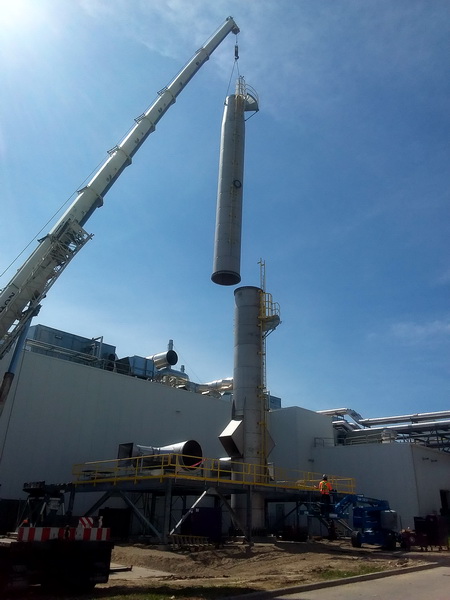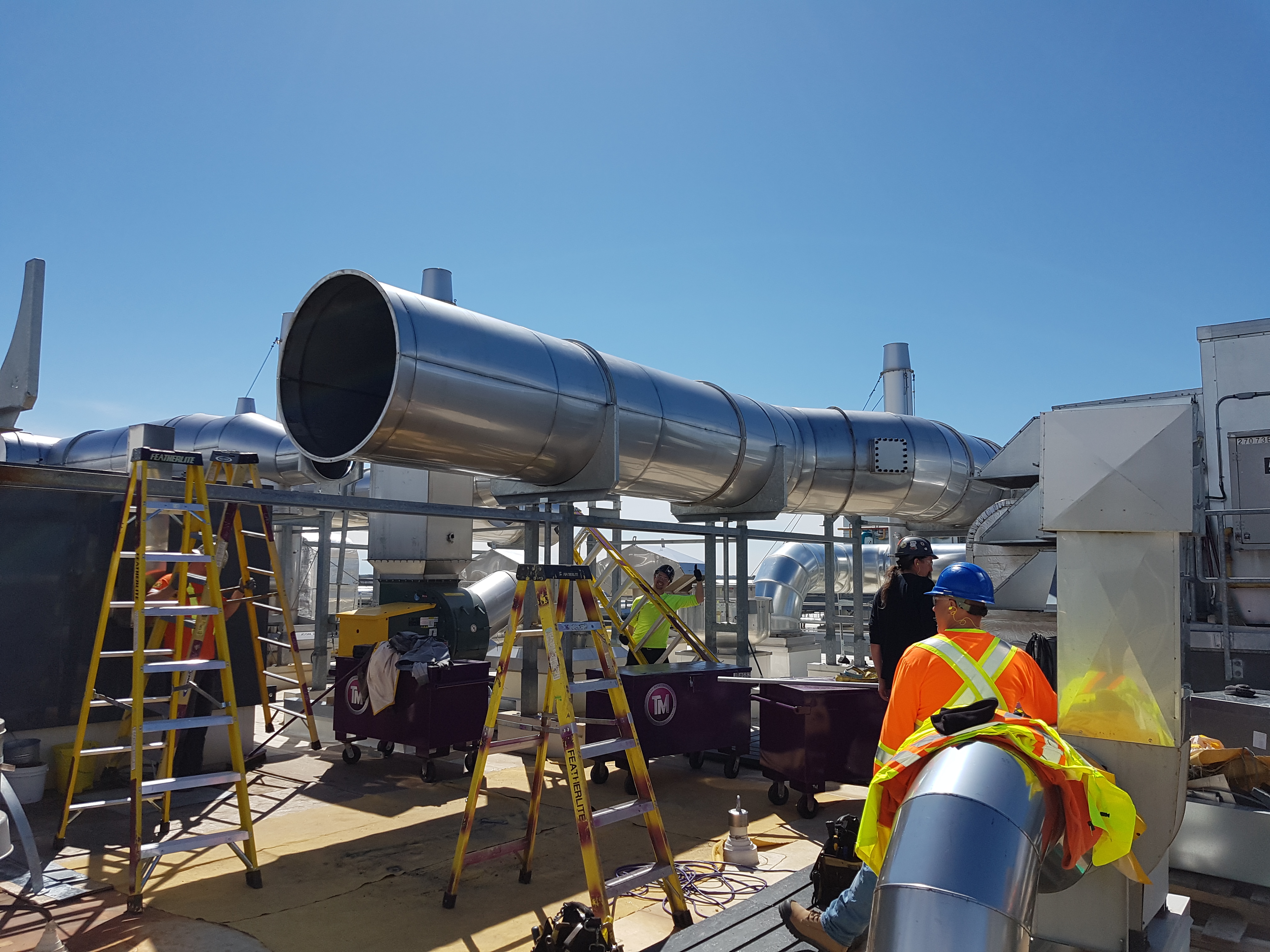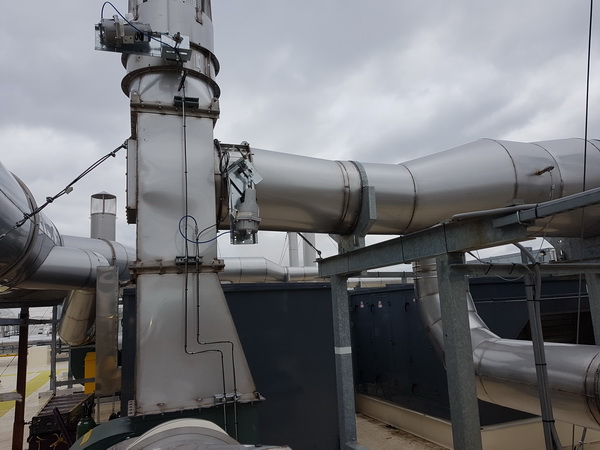Canadian Firm Revamps Plant Exhaust System
Trade-Mark Industrial Inc. of Cambridge, Ontario is flourishing in Canada’s booming economy. Trade-Mark has approximately 1,200 men and women in the field in locations as far west as Manitoba and the United States.

Trade-Mark’s crane hoists the upper stack into place.
Trade-Mark Industrial Inc. of Cambridge, Ontario is flourishing in Canada’s booming economy. Trade-Mark has approximately 1,200 men and women in the field in locations as far west as Manitoba and the United States.
In what the industrial contractor calls “a typical industrial project,” Trade-Mark recently modified and combined the exhaust system for a customers’ two-story, 402,000-square-foot meat production facility outside of Hamilton, Ontario. The goal of the project’s new exhaust system was to control odors in the plant. “The design required the exhaust systems from several production areas to be combined,” said George Colussi, Trade-Mark’s sheet metal and HVAC manager.
Trade-Mark is a multi-trade contractor and served as the general contractor for the project. “We did the structural fabrication, the electrical work and the pneumatic air lines, and we fabricated the ductwork in our Cambridge facility,” Colussi said. “Our people shared resources and equipment on-site and we handled all coordination between the crafts internally.”

Trade-Mark rooftop ductwork.
Trade-Mark owns a crane company, ROC (Royal Oak Cranes), that assisted with the project. “We began with one small boom truck and it was such an asset that we’ve expanded to 35 cranes at four locations in Southwestern Ontario.”
The heavy cranes were crucial to completing the project. Trade-Mark used their 350-pound crane to hoist 115,000 pounds of stainless steel ductwork up to the roof and onto pre-installed roof duct supports, which were fabricated in the shop.
“We removed the existing exhaust duct systems on the roof and installed larger new 70-inch diameter exhaust ducts,” Colussi noted “They ran along the roof and down to the new exhaust fans and into the new stack. Modifications were also made to the ductwork inside the plant to accommodate the increase in airflow.”
To vent production odors, Trade-Mark added a 115-foot-high, 84-inch diameter stainless steel exhaust stack. The stack had a structural access platform to support two variable speed exhaust fans. The high efficiency fans draw air through the stack at 50,000 cubic feet per minute. The stack releases odors into the atmosphere 85 feet above the facility roofline, 50 feet higher than the previous system did, thereby reducing the odors in the immediate area.

Ductwork with damper fan.
Trade-Mark worked on several weekends to avoid disrupting the customer’s production. “We are a 24/7 company,” Colussi said. “We receive calls around the clock and can react with teams of trades people to help clients get production up and running as soon as possible. We have built long-term relationships with many of our customers because they know we will get them back into production quickly. Production prevails over everything.”
Trade-Mark employees spent much of their time working on the plant roof and in utility spaces away from the actual food production. On rare occasions when they entered a production area, they wore protective clothing including booties and hair nets to comply with Canada’s strict food hygiene standards.
Working with crews on the roof in bad weather was also a challenge, however there were no cutting corners with safety. Trade-Mark engaged in assertive incident prevention and proactive safety planning.
“Every morning before the shift began the foreman would hold a safety talk with the whole crew that related to the day’s activity. Our crews wore harnesses, safety glasses, hard hats and work boots during the project,” Colussi said.
“We take safety seriously at Trade-Mark, and we want all our people to go home to their families at the end of the day.”
Published: April 29, 2019
IN THIS ISSUE
‘Smart’ Buildings Technology Growing More Common in HVAC Designs
Energy efficiency is not just about the environment, its about smart business. This Energy Efficiency Issue covers a myriad of energy efficient projects including Pittsburgh’s groundbreaking PNC Tower – and SMACNA contractors were there to bring it
A Green Roof Springs to Life
On top of a pharmaceutical company’s parking garage in Wilmington, Delaware, there grows a thriving patch of countryside, courtesy of SMACNA member Ernest D. Menold Inc.
Canadian Firm Revamps Plant Exhaust System
Trade-Mark Industrial Inc. of Cambridge, Ontario is flourishing in Canada’s booming economy. Trade-Mark has approximately 1,200 men and women in the field in locations as far west as Manitoba and the United States.
Developing Leaders Through Feedback
Collectively, companies spend billions of dollars for leader development, utilizing everything from public seminars to executive MBA programs at prestigious universities. While all of these have value, people sometimes overlook one of the simplest
Geauga Mechanical Contributes to Luxury High-Rise’s LEED Status
Expertise in energy efficiency and early involvement in the planning process were the keys to a successful residential – and landmark – project for Geauga Mechanical of Chardon, Ohio, according to CEO Craig Berman, LEED AP, CEM.
President’s Column: Building on the Benefits of Energy Efficiency
Today’s emphasis on energy management provides contractors with several opportunities to expand their businesses and help buildings become more energy efficient.
San Diego Crime Lab Requires Complex Systems
Associate Mechanical Contractors' complex HVAC system for the San Diego county Crime Lab helped it achieve LEED-Gold status.
SMACNA Endorses Bipartisan Bill to Speed Hospitality Retrofits
SMACNA has enthusiastically expressed support for the bipartisan bill, Restoring Investments in Improvements Act of 2019 (S. 803), which would amend last year’s Tax Cuts and Jobs Act to boost renovations and retrofits for restaurants and retailers.
Solar Power Harnesses the Sunshine
Roofs can serve multiple purposes besides being the foundation for green roofs. Harnessing the power of the sun, for instance, as a solar energy source for buildings and homes. Some SMACNA contractors are venturing into the solar market, offering
Testing and Balancing: Making a Difference in Energy Efficiency
SMACNA’s testing, adjusting, and balancing contractors are expanding their businesses by focusing on building systems and helping building owners and operators utilize their HVAC systems more efficiently.
University Innovation Center Designed for Collaboration
The roof and façade design for a new academic building project created “the perfect blend of high-tech and natural esthetics” for the University of Maryland’s new Brendan Iribe Center for Computer Science and Engineering, according to Scott Callaway


